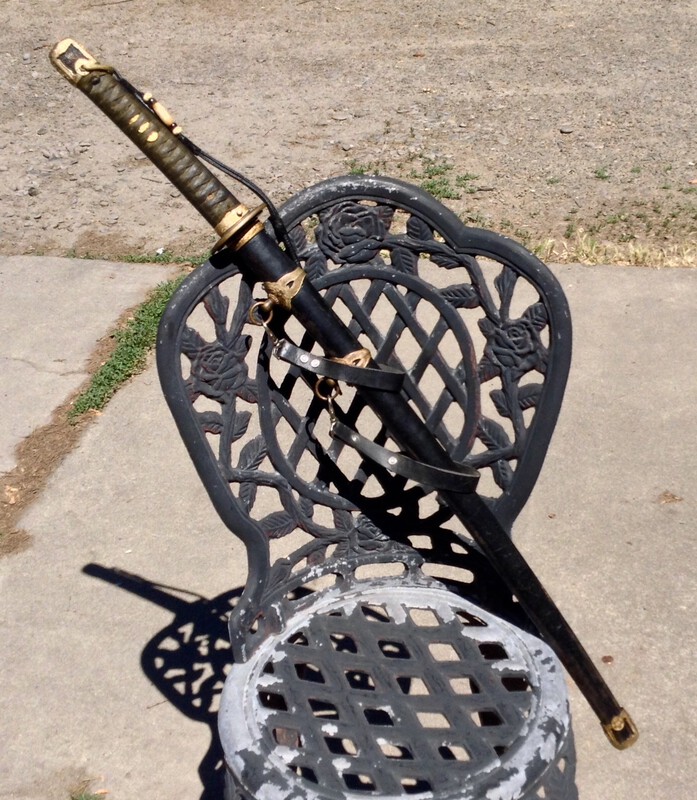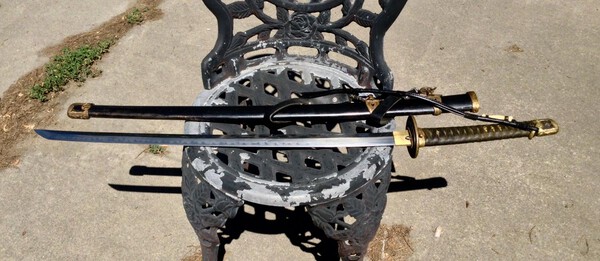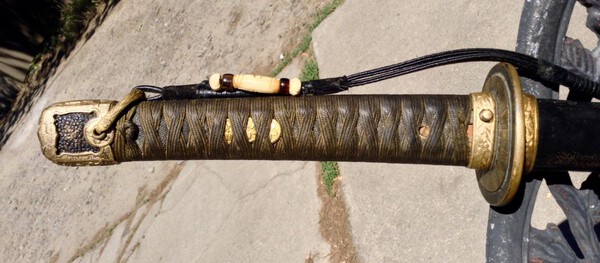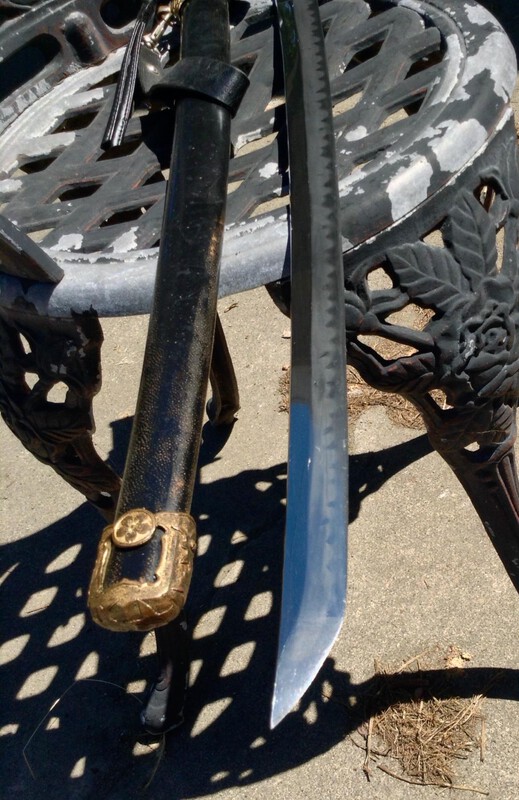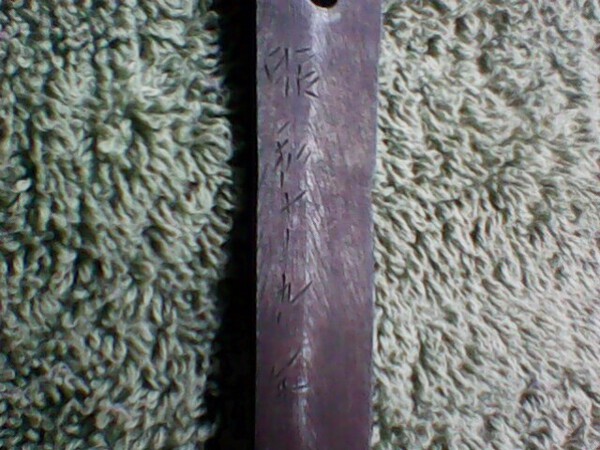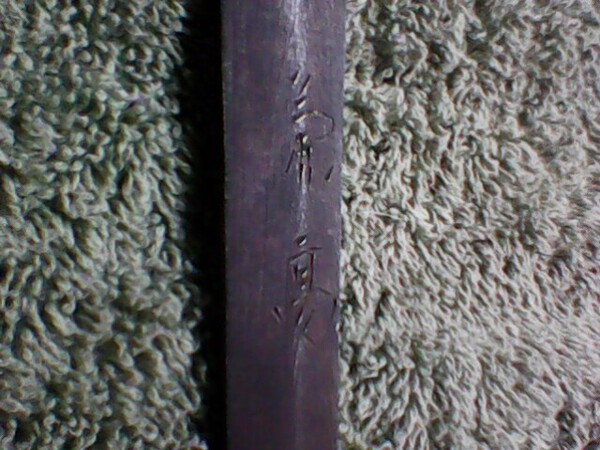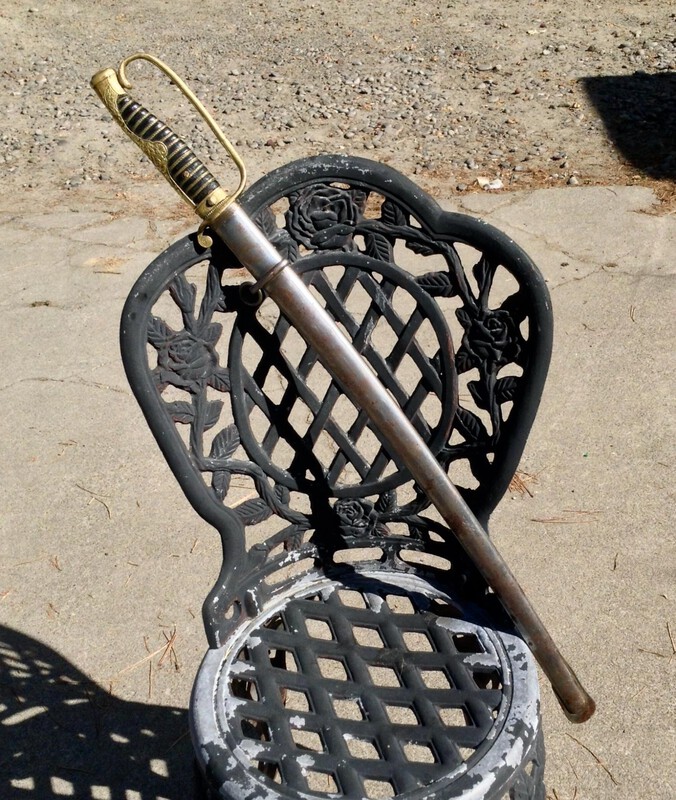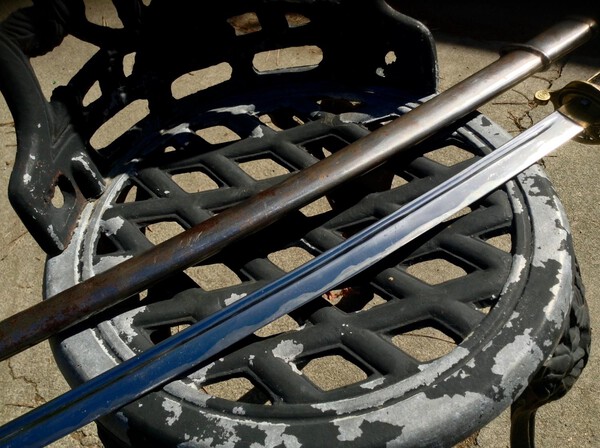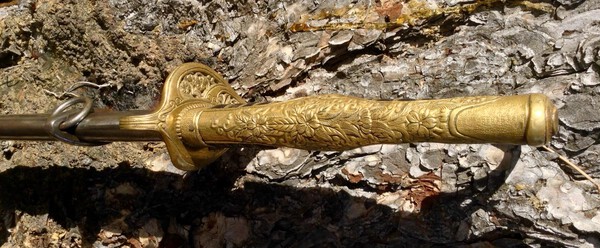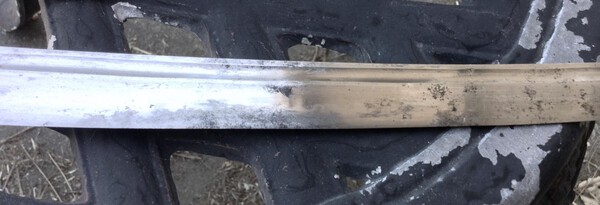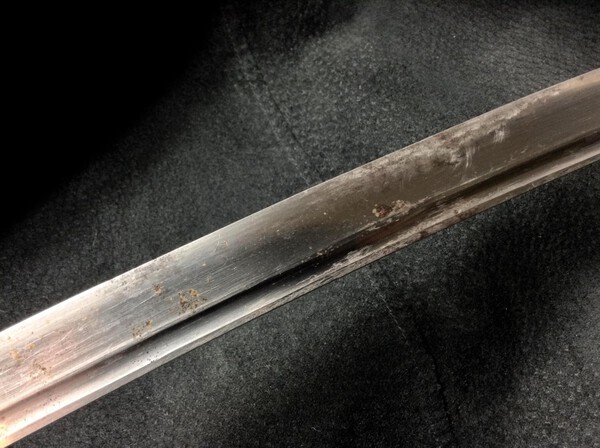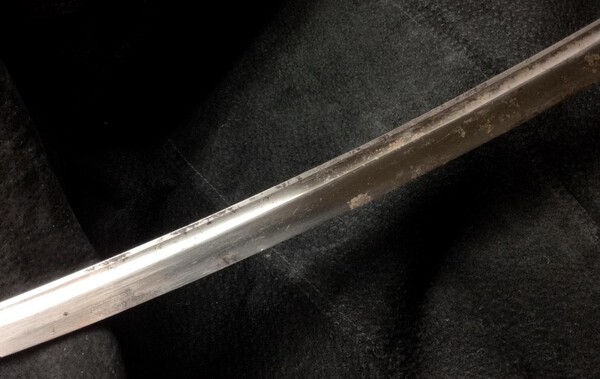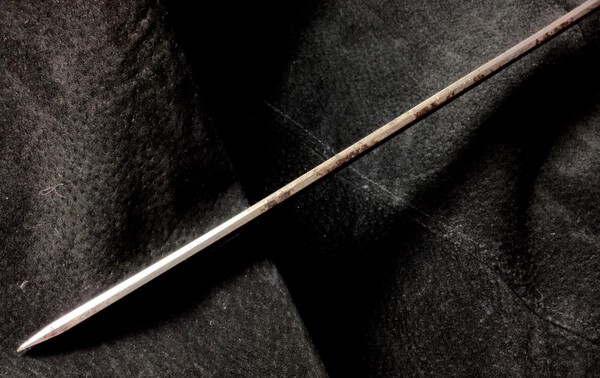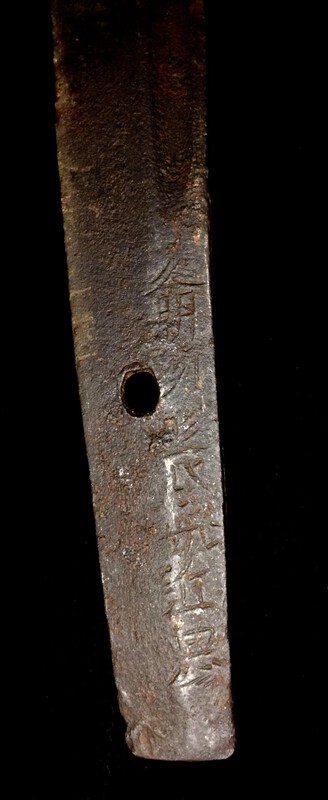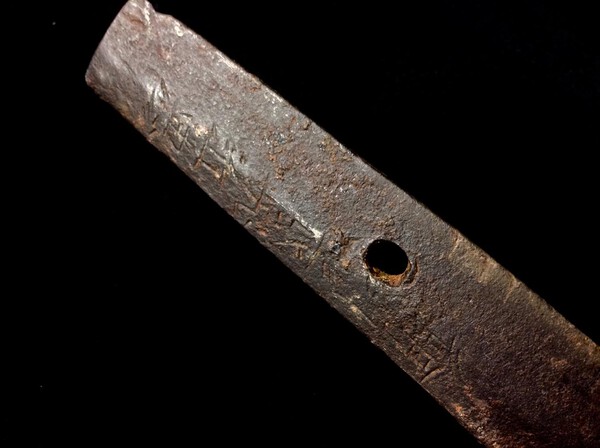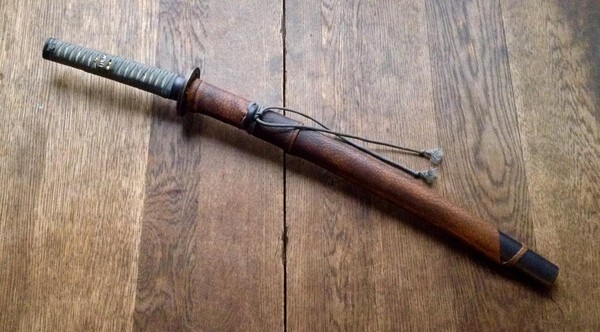-
Posts
28 -
Joined
-
Last visited
Profile Information
-
Location:
Medford, Oregon, USA
-
Interests
Weapons, model building, writing (and others)
Zoom Rabbit's Achievements
-
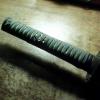
Show Us Your High Class Gunto
Zoom Rabbit replied to lonely panet's topic in Military Swords of Japan
What you can't see in my pictures, because I take great pains to conceal them, are the white cotton handkerchiefs folded up and upon which the steel is actually resting. Nothing shall stain my blades except the blood of my enemy, sir! -

Show Us Your High Class Gunto
Zoom Rabbit replied to lonely panet's topic in Military Swords of Japan
Well, my collection is humble. I have but two guntos: a nice gendai kai gunto by Kuwayama Kanetaka in 1944, and a fine kyu gunto with a blade that strikes me as machine made...but is in the kind of mounts I'm told were designed to take older blades. I'll do a thread about the kyu gunto some day, but here they both are, for now. (Please forgive the modern hangers and sword knot on the kai gunto; I do have an eye out for authentic ones.) I also have an NCO sword. Is that considered a gunto? -
*(Puts on his Indiana Jones hat.)* That sword belongs in a museum! Just kidding. I think the sword belongs in a large enough collection of nihonto that it could be appreciated in its proper context. That rules out me, and anyone else who can't afford the price tag...but if the seller holds firm on that, it should wait long enough for just that buyer to come along. Also, that much damage would bother me. I'd own, but wouldn't feel good about it unless I had a room full of old swords in shira-saya.
-

Strangely Mounted Tanto Mystery
Zoom Rabbit replied to Zoom Rabbit's topic in General Nihonto Related Discussion
I get it now. I shouldn't have posted this topic in this forum. My question wasn't generally nihonto related enough. Sorry for wasting everyone's time. -

Strangely Mounted Tanto Mystery
Zoom Rabbit replied to Zoom Rabbit's topic in General Nihonto Related Discussion
Real Japanese mounts for this blade? Never! I was talking about Chinese mounts for Chinese blade... I am a sword and knife collector, with three (and possibly four) nihonto in my collection. I already discussed one, my wakizashi, in the translation forum. But here's the thing--I collect blades from ALL nations and peoples. Most of my collection is genuine antique in nature, but there are a few of what you would call fakes. I consider them modern commercial swords, and yes, they are mostly Chinese. I do buy damaged pieces if it is something I can repair, which is an enjoyable hobby. I can try my hand at ito-maki, make battle covers and other stuff without damaging something that is authentic Japanese. I will say this. There is no stainless steel or plastic dragon handled sword in my collection. My hopes for this piece were that it had at least been made in the last century, and I appreciate the heads up that the tang was aged artificially. I still don't see what is so contemptible about putting more appropriate mounts on the thing. It's a stout little blade, very sharp. I have a twenty invested in this thing, and if I fix it up I will have something I can sell some day for two twenties. If I do, though, be assured that I would NEVER try to deceive a buyer into thinking it were an authentic Japanese tanto. I believe in karma. -

Strangely Mounted Tanto Mystery
Zoom Rabbit replied to Zoom Rabbit's topic in General Nihonto Related Discussion
Yes, it is true that I am much less knowledgeable than most, if not all, of you guys on this subject. That is why I brought the matter here; while I knew it was of Chinese make, I thought the style of mounting might be a Japanese type I hadn't seen before. I apologize if I wasted anyone's time, but I came earnestly seeking answers. What I don't understand is the negative tone I'm finding. Is this how one treats those less knowledgeable? Is this how one treats a guest? If I were talking to the lot of you in person, I doubt I would get the same hammering. -

Strangely Mounted Tanto Mystery
Zoom Rabbit replied to Zoom Rabbit's topic in General Nihonto Related Discussion
*Sigh* Please take the time to read my post and note that my name is located very notably in my signature. As for the rest...I will waste my time as I see fit. Have a nice day. -

Strangely Mounted Tanto Mystery
Zoom Rabbit replied to Zoom Rabbit's topic in General Nihonto Related Discussion
I've done a lot of google image searching in researching this...and no, there appear to be no other examples of this mounting. I'm going to have to guess that this is unique. Someone probably had a ruined dagger and salvaged the intact pieces to make their own variation. This would explain the larger hole freshly drilled in the tang. The saya and tsuka are both simple leather sleeves, no wood involved in their construction. Apparently, leatherwork was in the maker's bag of tricks, but not woodworking. Being a cheap Chinese blade, there is nothing to be lost in re-mounting it myself. I'll keep an eye out for an appropriately sized tanto with a blade that needs to go, and make a day off project out of it. The tang may be artificially aged, but the presence of rust tells me at least one thing: it isn't stainless steel. I'll give it a second life. If I'm wrong, and this is a standard mounting of some kind..I'd really like to hear about it. I would preserve an ethnographic variation as an example, but if it's someone else's re-mounting, I can do my own work to it. Gonna call this one solved, otherwise. Thanks, guys. -

Strangely Mounted Tanto Mystery
Zoom Rabbit replied to Zoom Rabbit's topic in General Nihonto Related Discussion
If I gave the impression that I thought this might be Japanese, I apologize for the confusion. I'm only familiar with Chinese stuff from this century. Does the rust indicate it might be an antique? I've only seen a rusty tang on twentieth century work (or earlier.) I also wonder about the red leather mounting. Has anyone seen this before? -
Greetings, fellow sword enthusiasts. *(Bows.)* I came across an item at the local antique mall, tagged simply 'short sword.' At first glance it appeared Chinese in nature, too short to be a 'short sword,' I figured it to be a dagger, Chinese mounted in red leather. It was cheap, so I bought it. The blade appears to be a Japanese style tanto blade of ten inches or so in length: Disassembled, it has components in the style of Japanese koshirae...and the tang is shaped correctly. Unsigned. Closeup of the tang. It has some rust, but the end is crudely chiseled. The original mekugi ana was drilled out to accept a larger peg, leaving behind a jagged raised flange around the hole on one side. So, what do I have here? I assume it's Chinese like rice noodles...but the blade seems to have some age. Anyone seen this kind of mounting before?
-

Old wakizashi...? My first mei translation
Zoom Rabbit replied to Zoom Rabbit's topic in Translation Assistance
Late 1500's. Well, it does pre-date the Tokugawa shogunate. Cool factor! Rokujuro: I misspelled Osafune. That is life. This could also be not from Osafune, but it is likely that such a blade was chosen to fake a Kanemitsu...if that is what happened. Also, if this is a Bizento, well... I have inspected the dents on the mune, nicks in the edge and what appear to be blood stains in the steel. One may quibble over what is meant by 'combat,' but I am confident that it experienced misadventure of some kind. Shira-saya? You're absolutely right; the samurai kept their swords in shira-saya unless they were using them for combat. My bad. Thank you for mentioning the need for a professional polish and koshirae from Japan; I had almost forgotten. Meanwhile, I will admire the sword for what it is in the here and now. -

Old wakizashi...? My first mei translation
Zoom Rabbit replied to Zoom Rabbit's topic in Translation Assistance
Got it. I've learned a lot about my sword over the course of this thread, and I thank you guys. My sword was forged (probably) in the village of Ofasune, sometime during the 1400's. If I could go back in time, I would find the village itself quite busy with the production of sword making...like a Solingen, Germany or Toledo, Spain. My sword was made by a smith whose name was later removed when an unscrupulous owner chiseled over it to make it appear that Kanemitsu, one of Masamune's ten disciples, had made the sword a century earlier. The sword was used, fought with...bled upon. And then it was retired to shira-saya, where it stayed until the 20th century when occupying American forces confiscated it, and it was brought to my country. It was pulled out often over the course of several decades, not cared for and allowed to rust...then finally wound up in the pawn shop where I found it. I returned the sword to mounted condition and have been privileged to care for it these last few years. Although it still bears a lot of rust, much more has been removed with uichiko and 'elbow grease.' I keep it oiled, and seek to find better koshirae for it some day. I would like to get it repaired and repolished. The most important thing I've done is: I found out its history as best I could. And my sword is older than Europeans in America! That's pretty cool all on its own. Again, thanks guys, especially to Jean. -

Old wakizashi...? My first mei translation
Zoom Rabbit replied to Zoom Rabbit's topic in Translation Assistance
With the maker unknown, my goal is to determine at least what century it was made. Kanemitsu was working in the 1300's; if this is a Bizento from that time period, I would be happy with that. Any opinions on age or school of make? What is needed is more pics. Of the blade. A shot in daylight which shows off the one good spot of gunome shining through. The edge under fluorescent light. The kissaki. The yokote can be teased out on both sides, but doesn't hold still well for the camera. The bo-hi goes all the way to the (gi)mei on the tang. Another view of the edge. The hamon is visible, but a polish is needed to bring out any detail. The mune. The suspected 'parry marks' are visible. I would like to get the sword sharpened and polished. One can see a few nicks in the edge, and the point is actually missing, which need attention. I'll have to save up for a while first, because the bill for all that would be large... Overall blade length is 20 inches, 23 to the end of the tang. -

Old wakizashi...? My first mei translation
Zoom Rabbit replied to Zoom Rabbit's topic in Translation Assistance
Gimei?!? *(Takes wakizashi outside and trims the blackberries.)* Just kidding. Trying to follow along here; it seems someone altered the mei to attribute it to a famous Bizen smith, Kanemitsu? Well, thumbs down on that scoundrel. Here in 2015, I value the blade for its own sake, and just want to know something of the truth... Many thanks, Jean and Steve. Without you guys, many of us would own 'anonymous old Japanese swords.' -

Old wakizashi...? My first mei translation
Zoom Rabbit replied to Zoom Rabbit's topic in Translation Assistance
Howdy, all. Sorry to bump this topic, but I finally have the better pics that might help finally identify the maker of this sword. Right now, all I know is that someone named Maruko made this sword, and it was pretty there... From a different angle: Any ideas on the damaged area? All I see is chaos, but perhaps someone here can make sense of it. And there is this; I have redone the sword myself in a more traditional Japanese fashion. It now looks like this: I am interested in getting ahold of antique koshirae that I can use, and the proper materials. For example, I'm still tying the handle with parachute cord, although using just the sleeve, because I don't have cotton ito. I would welcome advice.



